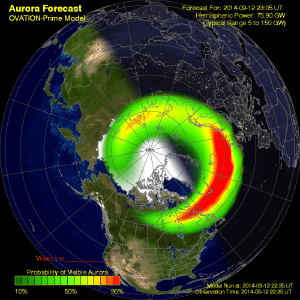Blog
Aurora Glow
13 September 2014
This week there’s been plenty of solar activity, including a couple of x-class solar flares. Since these flares were aimed in Earth’s general direction there has been some murmuring about “the big one” but these aren’t remotely large in historical terms. They are, however, strong enough that millions could have a rare chance of viewing an aurora.
It all has to do with the way charged particles emitted by solar flares interacts with Earth’s magnetic field. When a charge enters a magnetic field, the magnetic field causes a charge to spiral along the magnetic field. For this reason magnetic fields tend to trap charges along their field lines. The charges generally stay trapped unless they collide with each other (not likely in interstellar space) or interact with something else, such as our atmosphere.
 NOAA
NOAAIt is this effect that causes the aurora we see in the polar regions of our planet. The solar wind given off by our sun consists of charged particles, and those particles get trapped by the sun’s magnetic field. As a result they spiral outward until they interact with Earth’s magnetic field. Most of the solar wind gets repelled by our magnetic field, but some of the charged particles get trapped by Earth’s field. Those particles then spiral along our field and are funneled to either the north or south magnetic pole. When these charges hit our upper atmosphere they can ionize oxygen and nitrogen atoms. Oxygen excitations tend to be greenish, while Nitrogen tends to be reddish, though you can get some other colors as well. They are commonly known as aurora, or “northern lights.” Te effect also occurs in the southern hemisphere, but unless you happen to be in Antarctica the chance to observe the “southern lights” is pretty low.
Typically these aurora only appear in the northern-most regions, such as Alaska and northern Canada, but when there is strong solar activity they can be seen a bit farther south. In this case, some of the lower 48 in the U.S. as well as parts of Europe. The exact location can vary, but you check if your region has favorable conditions at several websites, such as NOAA’s OVATION Aurora.
If you have a chance to view an aurora, it is worth seeing.